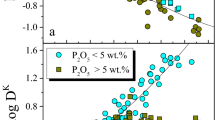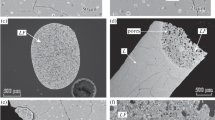Abstract
This study investigates partitioning of elements between immiscible aluminosilicate and borosilicate liquids using three synthetic mixtures doped with 32 trace elements. In order to get a good spatial separation of immiscible liquids, we employed a high-temperature centrifuge. Experiments were performed at 1,050–1,150°C, 1 atm, in sealed Fe and Pt containers. Quenched products were analysed by electron microprobe and LA ICP-MS. Nernst partition coefficients (D’s) between the Fe-rich and Si-rich aluminosilicate immiscible liquids are the highest for Zn (3.3) and Fe (2.6) and the lowest for Rb and K (0.4–0.5). The plots of D values against ionic potential Z/r in all the compositions show a convex upward trend, which is typical also for element partitioning between immiscible silicate and salt melts. The results bear upon the speciation and structural position of elements in multicomponent silicate liquids. The ferrobasalt–rhyolite liquid immiscibility is observed in evolved basaltic magmas, and may play an important role in large gabbroic intrusions, such as Skaergaard, and during the generation of unusual lavas, such as ferropicrites.





Similar content being viewed by others
References
Ariskin AA (2002) Geochemical thermometry of layered series rocks of the Skaergaard intrusion. Petrology 10:495–518
Ariskin AA, Petaev MI, Borisov AA, Barmina GS (1997) METEOMOD: a numerical model for the calculation of melting-crystallization relationships in meteoritic igneous systems. Meteorit Planet Sci 32:123–133
Bowen NL (1928) The evolution of igneous rocks. Princeton University Press, Princeton
Blundy J, Wood BJ (1994) Prediction of crystal-melt partition coefficients from elastic moduli. Nature 372:452–454
Daly RA (1914) Igneous rocks and their origin. McGraw Hill, New York
Dingwell DB, Pichavant M, Holtz F (1996) Experimental studies of boron in granitic melts. In: Grew ES, Anowitz LM (eds) Boron. Mineralogy, Petrology and Geochemistry, Mineralogical Society of America, Rev Mineral, vol 33, pp 331–386
Dixon S, Rutherford MJ (1979) Plagiogranites as late-stage immiscible liquids in ophiolite and mid-ocean ridge suites: an experimental study. Earth Planet Sci Lett 45:45–60
Dorfman AM, Hess K-U, Dingwell DB (1996) Centrifuge-assisted falling-sphere viscosimetry. Eur J Mineral 8:507–514
Ertel W, O’Neil HStC, Dingwell DB, Spettel B (1996) Solubility of tungsten in a haplobasaltic melt as a function of temperature and oxygen fugacity. Geochim Cosmochim Acta 60:1171–1180
Gibson SA (2002) Major element heterogeneity in Archean to recent mantle plume starting-heads. Earth Planet Sci Lett 95:59–74
Gibson SA, Thompson RN, Dickin AP (2000) Ferropicrites: geochemical evidence for Fe-rich streaks in upwelling mantle plumes. Earth Planet Sci Lett 174:355–374
Greig JW (1927) Immiscibility in silicate melts. Am J Sci 13:133–154
Hess PC (1995) Thermodynamic mixing properties and the structure of silicate melts. In: Stebbins JF, McMillan PF, Dingwell DB (eds) Structure, dynamics and properties of silicate melts. Mineralogical Society of America, Rev in Mineral, vol 32, pp 145–190
Holzheid A, Borisov A, Palme H (1994) The effect of oxygen fugacity and temperature on solubilities of nickel, cobalt, and molybdenum in silicate melts. Geochim Cosmochim Acta 58:1975–1981
Horng W-S, Hess PC (2000) Partition coefficients of Nb and Ta between rutile and anhydrous haplogranite melts. Contrib Mineral Petrol 138:176–185
Hudon P, Baker DR (2002a) The nature of phase separation in binary oxide melts and glasses. I. Silicate systems. J Non-Cryst Solids 303:299–345
Hudon P, Baker DR (2002b) The nature of phase separation in binary oxide melts and glasses. III. Borate and germanate systems. J Non-Cryst Solids 303:354–371
Hurai V, Simon K, Wiechert U, Hoefs J, Konečný P, Huraiová M, Pironon J, Lipka J (1998) Immiscible separation of metalliferous Fe/Ti-oxide melts from fractionating alkali basalt: P–T–fO2 conditions and two-liquid elemental partitioning. Contrib Mineral Petrol 133:12–29
Jakobsen JK, Veksler IV, Tegner C, Brooks CK (2005) Immiscible iron- and silica-rich melts in basalt petrogenesis documented in the Skaergaard intrusion. Geology 33:885–888
Kilinc A, Gerke T (2003) Compositional dependency of Fe–Mg exchange between olivine and melt. In: The Geological Society of America, 2003 Annual Meeting, Abstract with Programs GSA 35(6):181
Kushiro I, Mysen BO (2002) A possible effect of melt structure on the Mg–Fe2+ partitioning between olivine and melt. Geochim Cosmochim Acta 66:2267–2272
Levin EM, Robbins CR, McMurdie HF (1964) Phase equilibria diagrams, vol 1. American Ceramic Society, Columbus
Loferski PJ, Arculus RJ (1993) Multiphase inclusions in plagioclase from anorthosites in the Stillwater Complex, Montana: implications for the origin of the anorthosites. Contrib Mineral Petrol 114:63–78
Longerich HP, Jackson SE, Gunther D (1996) Laser ablation inductively coupled plasma mass spectrometric transient signal data acquisition and analytic concentration calculation. J Anal Atom Spectrom 11:899–904
Longhi J (1990) Silicate liquid immiscibility in isothermal crystallization experiments. In: Proceedings of the 20th Lunar Planet Science conference, pp 13–24
Markl G (2001) A new type of liquid immiscibility in peralkaline nepheline syenites (lujavrites) of the Ilimaussaq complex, South Greenland. Contrib Mineral Petrol 141:458–472
Martin B, Kushiro Y (1991) Immiscibility synthesis as an indicator of cooling rates in basalts. J Volcanol Geotherm Res 45:289–310
McBirney AR (1975) Differentiation of the Skaergaard intrusion. Nature 253:691–694
McBirney AR (1989) The Skaergaard layered series: I. Structure and average compositions. J Petrol 30:363–397
McBirney AR, Nakamura Y (1974) Immiscibility in late-stage magmas of the Skaergaard intrusion. Carnegie Inst Wash Yearbook 73:348–352
McBirney AR, Naslund HR (1990) The differentiation of the Skaergaard intrusion. A discussion of Hunter and Sparks (Contrib Mineral Petrol 95:451–461) Contrib Mineral Petrol 104:235–247
Mysen BO (2004) Element partitioning between minerals and melt, melt composition, and melt structure. Chem Geol 213:1–16
Naslund HR (1983) The effect of oxygen fugacity on liquid immiscibility in iron-bearing silicate melts. Am J Sci 283:1034–1059
Naslund HR, Henriquez F, Nystrom JO, Aguirre R, Lledo H (2003) El Laco, Chile; evidence for the eruption of an immiscible Fe–O–S–P melt. The Geological Society of America, 2003 Annual Meeting, Abstract with Programs GSA 35(6):394
Naumov VB, Solovova IP, Kovalenker VA, Rusinov VL (1993) Immiscibility in acidic magmas: evidence from melt inclusions in quartz phenocrysts of ignimbrites. Eur J Mineral 5:937–941
Nielsen TFD (2004) The shape and volume of the Skaergaard intrusion, Greenland: implications for mass balance and bulk composition. J Petrol 45:507–530
O’Neil HStC, Eggins SM (2002) The effects of melt composition on trace element partitioning: an experimental investigation of the activity coefficients of FeO, NiO, CoO, MoO2 and MoO3 in silicate melts. Chem Geol 186:151–181
O’Neil HStC, Pownceby MI (1993) Thermodynamic data from redox reactions at high temperatures. I. An experimental and theoretical assessment of the electrochemical method using stabilized zirconia electrolytes, with revised values fro the Fe–“FeO”, Co–CoO, Ni–NiO and Cu–Cu2O oxygen buffers, and new data for the W–WO2 buffer. Contrib Mineral Petrol 114:296–314
Pearce NJG, Perkins WT, Westgate JA, Gorton MP, Jackson SE, Neal CR, Chenery SP (1997) A compilation of new and published major and trace element data for NIST SRM 610 and NIST SRM 612 glass reference materials. J Geostand Geoanal 21:115–144
Philpotts AR (1976) Silicate liquid immiscibility: its probable extent and petrogenetic significance. Am J Sci 276:1147–1177
Philpotts AR (1979) Silicate liquid immiscibility in tholeiitic basalts. J Petrol 20:99–118
Philpotts AR (1982) Compositions of immiscible liquids in volcanic rocks. Contrib Mineral Petrol 80:201–218
Prowatke S, Klemme S (2005) Effect of melt composition on the partitioning of trace elements between titanite and silicate melt. Geochim Cosmochim Acta 69:695–709
Rajesh HM (2003) Outcrop-scale silicate liquid immiscibility from an akali syenites (A-type granitoid)-pyroxenite association near Puttetti, Trivandrum Block, South India. Contrib Mineral Petrol 145:612–627
Roedder E (1951) Low-temperature liquid immiscibility in the system K2O–FeO–Al2O3–SiO2. Amer Mineral 36:282–286
Roedder E (1979) Silicate liquid immiscibility in magmas. In: Yoder HS Jr (ed) The evolution of igneous rocks, Fiftieth Anniversary perspectives. Princeton University Press, Princeton, pp 15–58
Roedder E, Weiblen PW (1970) Lunar petrology of silicate melt inclusions, Apollo 11 rocks. In: Proceedings of the Apollo 11 Lunar Science Conference. Geochim Cosmochim Acta 1(Suppl 1):507–528
Roedder E, Weiblen PW (1971) Petrology of silicate melt inclusions, Apollo 11 and Apollo 12 and terrestrial equivalents. In: Proceedings of the 2nd Lunar Science Conference. Geochim Cosmochim Acta 1(Suppl 2):507–528
Roeder PL, Emslie RF (1970) Olivine–liquid equilibrium. Contrib Mineral Petrol 29:275–289
Ryerson FJ, Hess PC (1978) Implications of liquid–liquid distribution coefficients to mineral–liquid partitioning. Geochim Cosmochim Acta 42:921–932
Schmidt MW, Connolly JAD, Günther D, Bogaerts M (2006) Element partitioning—the role of melt structure and composition. Science 312:1646–1650
Scrope GP (1825) Consideration on volcanoes, the probable cause of their phenomena, the laws which determine their march, the disposition of their products and their connexion with the present state and past history of the globe; leading to the establishment of a new theory of the Earth. J Murray, London
Shannon RD (1976) Revised effective ionic radii and systematic studies of interatomic distances in halides and chalcogenides. Acta Crystallogr A 32:751–767
Shearer CK, Papike JJ, Spilde MN (2001) Trace element partitioning between immiscible lunar melts: An example from naturally occurring lunar melt inclusions. Am Mineral 86:238–241
Sørensen H, Bailey JC, Kogarko LN, Rose-Hansen J, Karup-Møller S (2003) Spheroidal structures in arfedsonite lujavrite, Ilimaussaq alkaline complex, South Greenland—an example of macro-scale liquid immiscibility. Lithos 70:1–20
Stemprok MS (1974) Geological importance of immiscibility in melts of silicate systems containing tungsten and molybdenum (in Russian). Izv Akad Nauk SSSR, Ser Geol 4:60–71
Tien TY, Hummel FA (1962) System SiO2–P2O5. J Am Ceram Soc 45:422–424
Toplis MJ (2005) The thermodynamics of iron and magnesium partitioning between olivine and liquid: criteria for assessing and predicting equilibrium in natural and experimental systems. Contrib Mineral Petrol 149:22–49
Toplis MJ, Carroll MR (1995) An experimental study of the influence of oxygen fugacity on Fe–Ti oxide stability, phase relations, and mineral-melt equilibria in ferro-basaltic systems. J Petrol 36:1137–1171
Veksler IV (2004) Liquid immiscibility and its role at the magmatic-hydrothermal transition: a summary of experimental studies. Chem Geol 210:7–31
Veksler IV, Petibon C, Jenner G, Dorfman AM, Dingwell DB (1998) Trace element partitioning in immiscible silicate and carbonate liquid systems: an initial experimental study using a centrifuge autoclave. J Petrol 39:2095–2104
Veksler IV, Dorfman AM, Dingwell DB, Zotov N (2002) Element partitioning between immiscible borosilicate liquids: a high-temperature centrifuge study. Geochim Cosmochim Acta 66:2603–2614
Veksler IV, Dorfman AM, Kamanetsky M, Dulski P, Dingwell DB (2005) Partitioning of lanthanides and Y between immiscible silicate and fluoride melts, fluorite and cryolite and the origin of the lanthanide tetrad effect in igneous rocks. Geochim Cosmochim Acta 69:2847–2860
Vicenzi E, Green T, Sie S (1994) Effect of oxygen fugacity on trace-element partitioning between immiscible silicate melts at atmospheric pressure: a proton and electron microprobe study. Chem Geol 117:355–360
Watson EB (1976) Two-liquid partition coefficients: experimental data and geochemical implications. Contrib Mineral Petrol 56:119–134
Wiebe RA (1997) Fe-rich tholeiitic liquids and their cumulate products in the Pleasant Bay layered intrusion, coastal Maine. Contrib Mineral Petrol 129:255–267
Acknowledgments
Dieter Rhede, Oona Appelt (GFZ Potsdam), and John Spratt (NHM London) are thanked for the help with electron microprobe analyses. Experimental work was supported by the DFG SPP 1055 grant to DBD (Di 431/23-1). IVV visits to NHM London were financed by CERCAMS, and a grant from EU SYNTHESYS programme. Comments of two anonymous reviewers helped us to improve the original version of the manuscript.
Author information
Authors and Affiliations
Corresponding author
Additional information
Communicated by J. Hoefs
Rights and permissions
About this article
Cite this article
Veksler, I.V., Dorfman, A.M., Danyushevsky, L.V. et al. Immiscible silicate liquid partition coefficients: implications for crystal-melt element partitioning and basalt petrogenesis. Contrib Mineral Petrol 152, 685–702 (2006). https://doi.org/10.1007/s00410-006-0127-y
Received:
Accepted:
Published:
Issue Date:
DOI: https://doi.org/10.1007/s00410-006-0127-y




